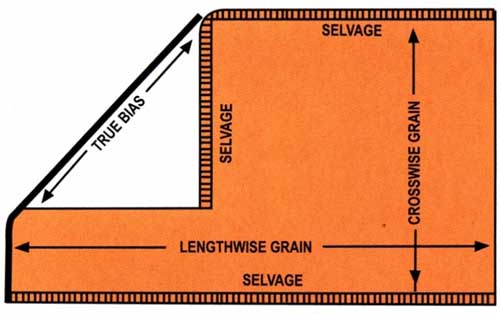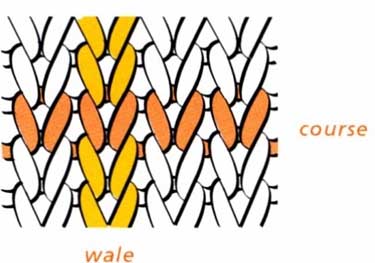|
Now that you’ve purchased your pattern and fabric and notions, you’re excited about your new project and anxious to start cutting immediately. Don’t be so eager to begin that you neglect the all-important preparation. Fabric and pattern may both need attention before you do the final layout and start sewing. Proper preparation will make your sewing experience much more successful, enjoyable -- and less time-consuming. |
Fabric TerminologyBefore preparing and cutting your fabric, it is important to understand the terminology for woven and knitted fabrics. Here is some common terminology used when talking about fabrics that will help you sound like a pro. Grain—the direction in which the threads composing the fabric run. Every woven fabric consists of crosswise threads worked under and over the more sturdy lengthwise threads. Selvage—the narrow, flat, woven border resulting at both lengthwise sides when the crosswise threads change direction. The threads composing it are strong and densely woven. This border is a pre-finished edge, and may be used to advantage for center back seams, waistbands, as a stay instead of twill tape, and much more. Lengthwise Grain—the direction of the lengthwise threads running parallel to the selvage. These threads are very strong and stable, as they must withstand great tension during the weaving process. Generally, fabrics are cut along the lengthwise grain for this reason. Sometimes know as “straight-of-fabric” or “straight-of-goods”. Crosswise Grain—the direction of the crosswise threads, running from selvage to selvage at right angles to the lengthwise threads. In most fabrics, it has a very slight amount of give. Bias—any diagonal intersecting the lengthwise and crosswise threads. Fabric cut on the bias possesses much greater elasticity than that cut on the crosswise grain. |
Are you looking for sewing or crafts-related items such as sewing machines, sergers, yarn, and knitting supplies? Try our online catalog pages here.
Or see what products on our site the popular search engines have chosen to list...
- Google listing of all "Sewing" items on our site
- Yahoo! listing
of all "Sewing" items on our site
- Alta Vista listing of all "Sewing" items on our site
Recommended Reading
Recommended Products
5 Drawer Foldaway Desk: Perfect for your sewing machine or serger! Constructed from durable melamine laminated particle board the Mobile Desks will offer a life time of reliable service.
If you need specific sewing supplies, browse through the products on pages like these:
- Brands of Overlock Serger Sewing Machines: Brother Serger and Coverstitch Machines and related items
- Singer Needles for Home Sewing Machines
- Industrial Sewing Machine Accessories

True Bias—is obtained by folding the on-grain fabric diagonally so the crosswise threads are parallel to the selvage. True bias exists at any 45° angle to any straight edge of fabric whose lengthwise and crosswise threads are perpendicular.
Bolt—is the packaged state of fabric. Fabric is sold to a store either folded or rolled lengthwise on a cardboard or metal form. You may find that the selvages are found on the top and bottom of the bolt or both selvages at one end and a fold at the other end. Knitted fabrics are structured of interlocking loops of yarn. They come either flat or tubular. Tubular knits can be cut open along one edge.
Wales or Ribs—are columns of loops running parallel to the long measurement of a knitted fabric. They correspond to the lengthwise grain of a woven fabric.
Courses—are the crosswise rows of loops of a knitted fabric.

